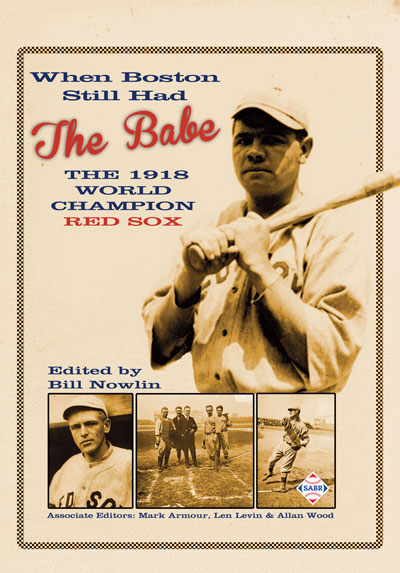1918 World Series: Most Valuable Player
This article was written by Bill Nowlin
This article was published in 1918 Boston Red Sox essays
 If an official MVP had been chosen for the 1918 World Series, the laurels would almost certainly have been placed on the brow of Red Sox outfielder George Whiteman. And what a way to wrap up his time in the majors: the 35-year-old’s last big league game was the clinching game of the 1918 Series.
If an official MVP had been chosen for the 1918 World Series, the laurels would almost certainly have been placed on the brow of Red Sox outfielder George Whiteman. And what a way to wrap up his time in the majors: the 35-year-old’s last big league game was the clinching game of the 1918 Series.
This is not revisionist history. A number of writers who covered the Series nominated Whiteman at the time for the honor. The Washington Post, for instance, offered as the subhead for its story on the sixth game: “Whiteman Hero of Contest.” J. V. Fitz Gerald of the Post declared that Whiteman “won the 1918 world’s baseball championship for the Red Sox.”
Before the World Series, the up-and-down Mr. Whiteman had only 258 major league at-bats – 12 in 1907 with the Red Sox, 32 more in 1913 with the New York Yankees, and 214 in 1918, again with the Red Sox. But when it came to the Series against the Chicago Cubs, manager Ed Barrow had him start in left field and bat cleanup in all six games. “Whitey” hit .250 with five hits in 20 at-bats, and scored two runs — unimpressive totals by today’s standards, perhaps, but this wasn’t a World Series noted for offense. Of all the batters with at least 10 at-bats, Whiteman’s batting average, hits, and runs scored all tied for his team’s lead.
Although Whiteman was the lone member of the Red Sox team to commit an error in the World Series, it was an inconsequential one. He contributed a number of key defensive plays (such as banging into the left-field bleacher wall in Chicago and robbing Dode Paskert of a long extra-base hit in Game Three) that helped hold the Cubs to their grand total of 10 runs scored over six games. The Red Sox scored only nine runs – but the Red Sox prevailed.
One way or another, Whiteman was involved in the rallies that brought in eight of the Red Sox’s nine runs. It was his “sizzling line drive” in the third inning (dropped for an error by Cubs right fielder Max Flack) that drove in both of Boston’s two runs in the clinching Game Six.
Whiteman’s final moment of glory came on defense, in the top of the eighth, when he made – again according to the Post – “one of the most sensational catches ever seen on a ball field to take a sure triple and possible home run from Turner Barber.” Whiteman wrenched his neck with his somersaulting catch and had to leave the game, but he did so to “one of the greatest ovations that has ever been accorded a world’s series player. Whiteman is the hero of the 1918 championship struggles.”
Hugh Fullerton’s nationally syndicated column ran in the Atlanta Constitution under the headline “Whiteman, Once Adjudged Failure, Becomes Star.” He termed Whiteman “the active principal in all four of the Red Sox victories.”
One could also make an MVP case for pitchers Carl Mays and Babe Ruth. Mays pitched complete game victories in Games Three and Six. In 18 innings, Mays allowed only 10 hits and three walks. The Cubs scored one run in each of his two starts which, of course, gave him an earned run average of 1.00.
Like Mays, Ruth was 2-0 on the mound, though with a slightly higher ERA and – with seven walks – somewhat less dominant (he was lucky to have allowed only two runs). Ruth was the only player on the team to have more than one run batted in; his triple in Game Four drove in two. It was Ruth who took Whiteman’s place in left after Whitey had hurt his neck. Prior to that, the only games in which Ruth played were those in which he pitched. It was Whiteman who played in each and every game and seemed to be a central figure in most of the plays that mattered.
BILL NOWLIN is national Vice President of SABR and the author of nearly 20 Red Sox-related books. Bill is also co-founder of Rounder Records of Massachusetts. He’s traveled to more than 100 countries, but says there’s no place like Fenway Park.


